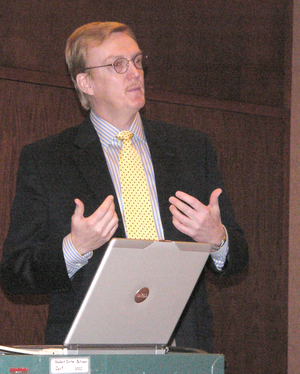CSC audience hears floral business is flourishing in Ohio

A group of farmers in the floriculture business in northeastern Ohio have learned there are advantages to joining forces to share ideas, make purchases and market their products.
That was the message delivered last Friday afternoon by Dr. Michael Carroll, director of the Center for Regional Development at Bowling Green University as he spoke to a room full of Chadron State students and faculty and a few community residents in the Student Center at CSC.
Backed by a grant from the U.S. Department of Agriculture, Carroll and a colleague at the University of Toledo have helped a group of bedding plant growers form a cluster-based organization that is assisting them in several ways.
“Cluster-based” would appear to be similar to the co-ops that have operated in Nebraska and surrounding states for many years. The idea is much the same: There are advantages to working together.
Carroll said most of the farmers who produce the bedding plants are from families that have been in the business several generations. They know how to produce quality plants and aren’t interested in becoming a huge conglomerate. Problems arise when the next generation doesn’t want to following in his or her forbearers’ footsteps. That’s when the business usually shuts down.
Carroll said there are a few greenhouses in the area that encompass up to 150 acres. Most of the production is seasonal, beginning in the late spring. Some have tried growing the plants the year-round, but the energy costs are too high to make it profitable.
The speaker said there are 82 greenhouses creating 764 jobs with an economic impact of about $100 million in the five-county area that he has worked with. Some 78 percent of the plants are sold to customers in Ohio.
An early survey showed that there was pessimism in the industry. Forty percent of the growers felt their businesses were becoming less profitable and 15 percent anticipated they would downsize or close in a few years.
Carroll said that since the growers know the production business well, it was never his idea to give them tips on how to grow better plants. But he felt there might be advantages in working together to make purchases, promote their products and generally share information.
“Relationships between people can be an asset,” he stated.
The first meeting Carroll organized was in October 2004 with just eight growers in attendance. After his concept was explained, he said most of growers were non-committal. They weren’t sure how they would benefit. But by the time the second meeting was held two months later, they were ready to embrace the idea.
“They had gotten together, talked about our proposal and decided something good might come out of it,” Carroll said. An advisory board was formed and both a project manager and a “champion,” or field representative, was hired.
At a recent meeting of the cluster members, at least 80 were in attendance, Carroll reported.
“We have found some ways to be collectively efficient,” Carroll said. They include receiving discounts from seed companies and other suppliers by making larger purchases, connecting with new and larger markets, accessing external funds and buying workman’s compensation coverage at lower rates.
He added that the joint effort has drawn the attention of the news media, both locally and from national greenhouse publications. Advertisements promoting the floriculture business were even placed on buses in Toledo, the major city in the region.
“They are starting to see the benefits of working together,” said Carroll. “Some are talking about opening new greenhouses or expanding their own operations. No one is talking about closing now. By working together they’ve found some collective efficiencies and there’s been an impact on the bottom line.”
The speaker noted that often producers join forces after a crisis develops. In this instance, it was done before there was a crisis, and economic growth has resulted.
Category: Campus News
